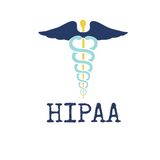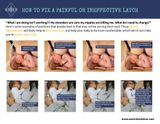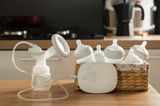When we talk about pain during breastfeeding, we are often talking about nipple pain or plugged ducts. Here I would like to talk about some of the causes of pain in breast while breastfeeding with no lump as well as other kinds of pain that parents may experience in the breast that less commonly talked about.
Opposite breast pain while breastfeeding
Opposite breast pain during breastfeeding or chestfeeding is a common experience for many nursing mothers. This pain may occur in one breast while the other breast is unaffected, and can be caused by a number of factors, including:
- Let down: Most people experience no sensation with letdown or milk ejection. This is where a cascade of hormones squeezes the milk ducts so that milk come out more easily. Some people experience let down with a warm or tingly sensation. Some people do find this sensation painful.
- Latching issues: Babies can have a good latch on one side and a poor latch on the other. It often has to do with tension in the baby’s head and neck. If the baby is not latching properly during breastfeeding or chestfeeding on that side, it can lead to pain and discomfort in one breast or chest. This can be caused by an improper latch or a tongue tie that prevents the baby from latching correctly.
- Engorgement: Breast engorgement can cause pain and discomfort in one breast, especially if the baby is not feeding frequently enough or effectively enough to relieve the engorgement, again a poor latch on one side may mean that only one side isn’t getting emptied often enough.
- Mastitis or a blocked duct: Mastitis is an infection of the breast or chest tissue that can cause pain, swelling, and redness in one breast or side of the chest. It can be caused by a bacterial infection or inflammation.
If you are experiencing opposite breast pain during breastfeeding, it's important to speak with a lactation consultant or healthcare professional. They can help identify the underlying cause of the pain and provide recommendations for relief, such as adjusting the breastfeeding position or using cold compresses to relieve engorgement. In some cases, additional treatment may be necessary to address an infection or other underlying issue.
Breast feels bruised breastfeeding
If your breast feels bruised while breastfeeding, it can be a sign of a few different issues. Here are some possible causes:
- Engorgement: Engorgement occurs when your breasts or chest are overfilled with milk and/or you have swelling in your breasts/chest, causing them to become tender. This can make your breasts or chest feel bruised or sore, especially while breastfeeding or chestfeeding
- Mastitis: Mastitis is a breast infection that can cause breast/chest pain, swelling, and redness. It can make your breast/chest feel bruised or sore to the touch, and you may also have a fever and flu-like symptoms. Subclinical mastitis may also be present with infection without other symptoms. (More info later in this post)
- Poor latch: If your baby is not latching onto your breast properly, it can cause discomfort and pain, which can feel like bruising. This can be due to a variety of factors, such as a tongue tie, a shallow latch, or positioning issues.
- Baby latches on to another part of the breast/chest: Sometimes when everyone is tired baby may latch on to the side of the breast or chest tissue instead of the nipple. This can lead to a bruise very quickly.
- Breastfeeding too long on one breast: Breastfeeding or chestfeeding for an extended period on one side can cause the breast/chest tissue to become tender and sore, which can feel like a bruise.
- Injury: An injury to your breast, such as accidentally bumping it or getting hit, can cause bruising and soreness.
If your breast feels bruised while breastfeeding or chestfeeding for more than a short period of time, it's important to speak with a healthcare professional to determine the underlying cause and receive appropriate treatment. They can help you identify any issues with your breastfeeding technique or recommend methods to alleviate engorgement or mastitis. In some cases, medication may be necessary to treat an infection or pain.
Most common cause of bruising in the breast or chest
I regularly see people who have done breast or chest massage to help with plugged ducts or engorgment end up with bruises in the breast or chest tissue. Breast lymphatic drainage massage can be an effective technique to help alleviate the symptoms of mastitis, such as pain, swelling, and inflammation. However, it's important to use proper techniques and avoid causing any additional discomfort or injury.
Here are some tips to help prevent bruising while performing breast massage for mastitis:
- Use gentle pressure: Avoid using too much pressure or force when massaging the breast tissue. Use the pressure you might use to pet a cat or check the ripeness of a tomato or avocado. Use gentle, circular motions to help stimulate lymphatic drainage which will increase repair.
- Use a cold compress: Applying a cold compress to the affected breast or chest before massaging can also help relax the breast or chest tissue and decrease inflammation. This can help reduce the risk of bruising.
- Take breaks: If you're experiencing discomfort or pain during breast massage, take a break and try again later. Avoid massaging the breast tissue for extended periods of time, as this can cause bruising and further irritation.
- Seek advice from a healthcare professional: If you're experiencing persistent pain or bruising during breast massage or chest massage, speak with a healthcare professional. They can provide guidance on proper massage techniques or recommend alternative treatments.
Overall, breast massage can be a helpful technique for treating mastitis, but it's important to use proper techniques and avoid causing any additional discomfort or injury. If you're experiencing persistent pain or bruising, speak with a healthcare professional for guidance.
Pain in breast while breastfeeding with no lump

Breastfeeding pain in breast no lump, is a common complaint I hear, while many associate mastitis with lumps in the breast or chest or blocked ducts. This does not have to be the case. Both acute and sub clinical mastitis can create pain in the breast while breastfeeding with no lump.
Acute mastitis
The American Academy of Breastfeeding Medicine (AABM) has outlined the following common symptoms of mastitis:
- Breast pain or tenderness: The affected breast may be sore, tender, or painful to the touch. This pain can range from mild to severe.
- Swelling and redness: The affected breast may be swollen, red, or warm to the touch. In some cases, a lump or area of hardness may be felt in the breast.
- Flu-like symptoms: Mastitis can cause flu-like symptoms such as fever, chills, and fatigue.
- Breast engorgement: The affected breast may become engorged or overfull, leading to discomfort or pain.
- Nipple discharge: In some cases, mastitis can cause a discharge from the nipple, which may be pus-like or contain blood.
It's important to note that not all people or women with mastitis will experience all of these symptoms, and some women may experience additional symptoms not listed here. Additionally, not all breast infections are mastitis, and other conditions, such as a breast abscess, can cause similar symptoms.
If you are experiencing any of the above symptoms, it's important to seek medical attention from a healthcare provider, as prompt treatment can help prevent complications and promote healing. A healthcare provider can perform a physical exam and recommend appropriate treatment, which may include antibiotics, pain relief, and other supportive measures.
Sub clinical mastitis
Subclinical mastitis is a type of breast/chest infection that may not cause noticeable symptoms, but can still lead to inflammation and damage to breast or chest tissue. The American Academy of Breastfeeding Medicine (AABM) notes that subclinical mastitis can be identified through testing of breast milk, but may not present with any noticeable symptoms. However, some women may experience mild symptoms such as:
- Slight breast tenderness: Some women with subclinical mastitis may experience mild breast tenderness, but it is often less severe than the pain associated with acute mastitis.
- Milk supply changes: Subclinical mastitis can cause changes in milk supply, including a decrease in milk production or a change in the appearance or texture of breast milk.
- Nipple discharge: Some women with subclinical mastitis may experience a discharge from the nipple, which may be pus-like or contain blood.
- Feeling unwell: Subclinical mastitis may cause a general feeling of being unwell, including fatigue or malaise.
It's important to note that not all people or women with subclinical mastitis will experience these symptoms, and some women may not experience any noticeable symptoms at all. However, subclinical mastitis can still lead to complications such as chronic breast pain or decreased milk production, and should be treated promptly by a healthcare provider. If you suspect you may have subclinical mastitis, it's important to speak with a healthcare provider for diagnosis and treatment recommendations.
Inflammatory breast cancer
Inflammatory breast cancer (IBC) is a rare and aggressive form of breast cancer that accounts for about 1-5% of all breast cancer cases in the United States. Unlike other types of breast cancer, IBC does not typically present as a distinct lump or mass, but instead manifests as diffuse redness, swelling, and warmth in the breast or chest. It isn't very common to get IBC while breastfeeding or chestfeeding but it is possible and can get over looked because the symptoms can be confused for common issues of lactation. Other symptoms may include:
- Thickening or dimpling of the skin: The skin over the affected breast may appear thickened or dimpled, similar to the texture of an orange peel.
- Breast pain or tenderness: IBC may cause pain or tenderness in the affected breast.
- Nipple changes: The nipple may appear flattened, inverted, or retracted.
- Swollen lymph nodes: IBC may cause swelling of the lymph nodes under the arm or near the collarbone.
- Flu-like symptoms: Some women with IBC may experience symptoms similar to the flu, such as fever, fatigue, and nausea.
It's important to note that these symptoms can also be caused by other conditions, and the presence of these symptoms does not necessarily mean a person has IBC, in fact in a lactating breast/chest it is much more likely to be something else. However, if you are experiencing any of these symptoms, it's important to speak with a healthcare provider as soon as possible for evaluation and diagnosis.
Treatment for IBC typically involves a combination of chemotherapy, radiation therapy, and surgery, and may be more aggressive than treatment for other types of breast cancer due to the rapid growth and spread of the cancer cells. Early diagnosis and prompt treatment can improve the prognosis for people with IBC, making it important to seek medical attention right away if you suspect you may have this condition.
As we have discovered here there are many reasons for sore breast breastfeeding with no lump, as well as bruising in the breast or chest, opposite breast pain while breastfeeding or chestfeeding. The solution for the pain lies in where the source of the pain is coming from. Support from a qualified lactation consultant or breast specialist is likely the best way to get to the bottom of your pain!




